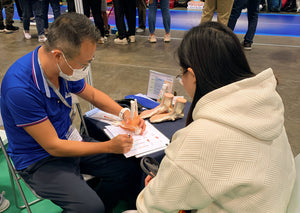
Komforttechnik:
Die Herstellung unserer ersten Einlegesohle
Präzision, Leistung, Möglichkeiten
Als NAT'S sich daran machte, seine erste technische Einlegesohle zu entwerfen, wollten wir mehr als nur eine stützende Schicht unter dem Fuß schaffen. Wir wollten ein reales Problem lösen: Wie können wir Komfort, Unterstützung und Bewegungssteuerung in einem intelligenten Design vereinen – insbesondere für Menschen, die sich gerne im Freien bewegen? Diese Mission führte uns zu einem einzigartigen Kooperationspartner: Thomas Law, einem zertifizierten Orthopädietechniker, klinischen Ausbilder und Elitemarathonläufer mit über 20 Jahren Erfahrung in der Entwicklung kundenspezifischer Einlegesohlen und biomechanischer Korrektur.
Von medizinischer Neugier zu handwerklichem Können
Thomas besitzt einen Bachelor of Science (Hons) in Prothetik und Orthopädie von der Hong Kong Polytechnic University und ist zertifizierter Pedorthist (USA). Er hat außerdem eine fortgeschrittene orthopädische Ausbildung in den USA und Irland absolviert, einschließlich des Boston Brace-Programms für Wirbelsäulenorthesen, und wurde vom RMPI Institute (Indiana) akkreditiert, um zertifizierte Fußorthesenkurse in ganz Asien anzubieten.
Seine Karriere umfasst sowohl klinische als auch Fertigungsbereiche. Von 1999 bis 2007 trug er zum Aufbau des Medizin- und Einzelhandelsgeschäfts bei, indem er die Herstellung von Fußorthotiken in Festlandchina etablierte und Hongkongs erstes Zentrum für kundenspezifische Einlegesohlen eröffnete.
Im Jahr 2008 gründete er das Foot & Spine Health Assessment Centre, das heute Kunden mit einer breiten Palette an orthopädischen Produkten versorgt – von Fußbetten bis hin zu Skoliose-Orthesen.
„Ich habe die Schnittstelle zwischen Wissenschaft und Handwerkskunst schon immer geliebt“, sagt Thomas. „Die Orthopädietechnik ermöglicht es mir, eng mit Menschen zusammenzuarbeiten und gleichzeitig fundiertes biomechanisches Wissen anzuwenden.“

Thomas arbeitet nicht nur mit Läufern zusammen – er ist selbst einer. Als leidenschaftlicher Ausdauersportler hat er an Dutzenden von 10-km-Läufen, Halbmarathons und vollständigen Marathons teilgenommen, darunter ein Zieleinlauf in 2:56:42 beim Hong Kong Standard Chartered Marathon 2013 – eine seiner persönlichen Bestleistungen.
Durch Coaching und konsequentes Training entwickelte sich das Laufen sowohl zu einem Lebensstil als auch zu einem lebendigen Labor. Heute absolviert Thomas während der Wettkampfsaison über 100 Kilometer pro Woche und nutzt jeden Schritt, um bessere Erkenntnisse für seine klinische Arbeit zu gewinnen.
„Ich hatte schon mit Plantarfasziitis, Achillessehnenentzündung, Rückenschmerzen, Knieproblemen zu kämpfen – was auch immer Sie sich vorstellen können. Und ich weiß, wie viel davon durch besseres Design verhindert werden könnte.“
Einer von Thomas' größten Erfolgen war es, einem Läufer nach einer schweren Verletzung zur Rückkehr in den Wettkampf zu verhelfen. In über neun Monaten individueller Behandlung und Training bauten sie nicht nur seine körperliche Form wieder auf, sondern auch sein Selbstvertrauen.
„In solchen Momenten versteht man, was richtige Unterstützung wirklich bedeutet“, reflektiert Thomas. „Es geht nicht nur um Trost. Es geht darum, jemandem zu helfen, wieder daran zu glauben, dass er sich bewegen kann.“

Die NAT'S-Verbindung: Gemeinsame Werte, gemeinsame Vision
Thomas wurde NAT'S durch eine gemeinsame Verbindung in der Schuhindustrie vorgestellt. Sobald er die Philosophie der Marke kennenlernte, erkannte er eine Übereinstimmung.
„Sie wollten nicht einfach nur einen weiteren Schuh herstellen – sie waren bereit, in geeignete Bewertungsinstrumente zu investieren, verschiedene Fußgewölbeprofile zu entwerfen und die Konstruktion der Innensohle zu überdenken. Dieses Engagement war erfrischend.“
Diese gemeinsame Vision führte zu einer Zusammenarbeit, um die erste adaptive Performance-Einlegesohle von NAT zu entwickeln.
Was ist das Besondere am Design der NAT'S-Einlegesohle?
Das Team nutzte ein vollständiges Gangzyklusmodell als Designgrundlage und unterteilte die Bewegung des Fußes in drei Hauptzonen:
1. Fersenzone – absorbiert Stöße bei der Landung
2. Mittelfuß – stabilisiert die Körperhaltung und korrigiert die Ausrichtung
3. Vorfuß – sorgt für Vortrieb und Energierückgabe
Die endgültige Zusammensetzung der Einlegesohle umfasst:
„ACF“ (Artificial Cartilage Foam) – eine leichte, elastische Verbindung, die Knorpel nachahmt und für federnde Elastizität sorgt.
„EVA-Schale“ – bietet umfassende strukturelle Kontrolle und Stabilität von Seite zu Seite.
„PU-Basisschicht“ – bietet weiche, langanhaltende Dämpfung für längere Ausflüge
„Vielfältige Optionen für die Höhe des Fußgewölbes“ – ermöglichen eine maßgeschneiderte Passform für verschiedene Fußtypen.
„Die meisten Einlegesohlen konzentrieren sich nur auf die Unterstützung des Fußgewölbes“, sagt Thomas. „NAT'S hat einen ganzheitlichen, auf den Gangablauf basierenden Ansatz gewählt. Das ist es, was sie auszeichnet.“

In der Praxis vermittelte die EVA-Schale ein Gefühl von „ umschließender Stabilität“, insbesondere in Kombination mit NAT'S Wanderschuhen. Die Kombination aus Mittelfußhalt und Vorfußfreiheit ermöglichte sowohl Halt als auch natürliche Ausdehnung bei langen Wanderungen.
Nichtsdestotrotz steht Innovation niemals still.
„Ich möchte den Vorfuß-Rückprall noch weiter verbessern“, sagt er. „Und die Lebensdauer der Einlegesohle bei starker Beanspruchung verlängern. Es gibt auch Potenzial, das Gewicht des Schuhs zu reduzieren und gleichzeitig die Stützfunktion beizubehalten.“
Für Personen mit leichten Fußstrukturproblemen – die nicht so schwerwiegend sind, dass sie eine vollständige, individuelle orthopädische Versorgung erfordern – bietet diese Einlegesohle genau das richtige Maß an gezielter Korrektur. Sie ist besonders hilfreich im Freien, wo unebenes Gelände sowohl die Stabilität als auch die Ermüdung der Füße beeinträchtigt.
Aus der Sicht der Materialwissenschaft fasst Thomas es einfach zusammen:
„PU “ = ausgezeichnet zur Stoßdämpfung bei bewegungsintensiven Aktivitäten wie Laufen
„EVA“ = hervorragend für seitliche Unterstützung und Torsionsstabilität im Gelände.
Zusammengenommen bieten sie ein ausgewogenes Verhältnis aus Schutz, Flexibilität und ganztägigem Komfort.
Eine Vision für die Zukunft
Letztendlich sieht er NAT'S als mehr als nur eine Schuhmarke. Er hofft, dass sie nicht nur für Outdoor-Enthusiasten, sondern auch für Berufstätige und ältere Erwachsene zur ersten Wahl wird, die sicheres, gesundes und stützendes Schuhwerk im Alltag wünschen.
„Da steckt riesiges Potenzial drin“, sagt er. „Wenn wir weiterhin gezielt entwickeln und in intelligente Biomechanik investieren, kann NAT'S zu einem vertrauenswürdigen Namen werden – nicht nur für Outdoor-Stil, sondern für echten, dauerhaften Komfort.“
Bei NAT'S glauben wir nicht an Komfort von der Stange.
Wir glauben an intelligente Unterstützung – für jeden Fuß, jeden Schritt und jede Reise.

